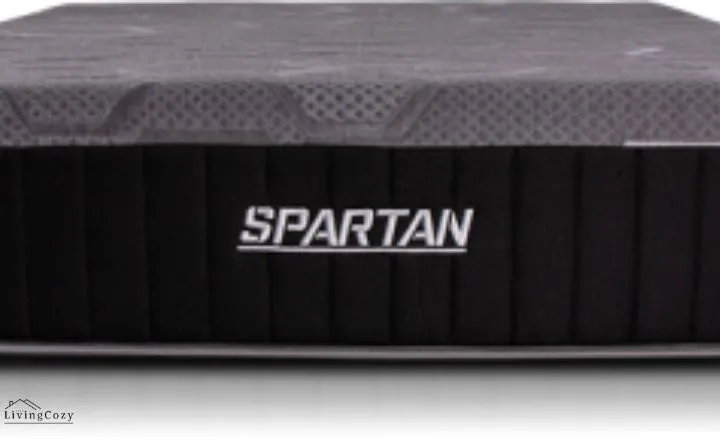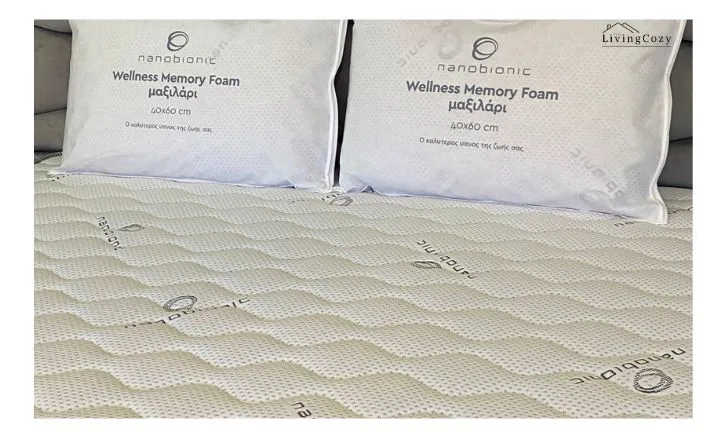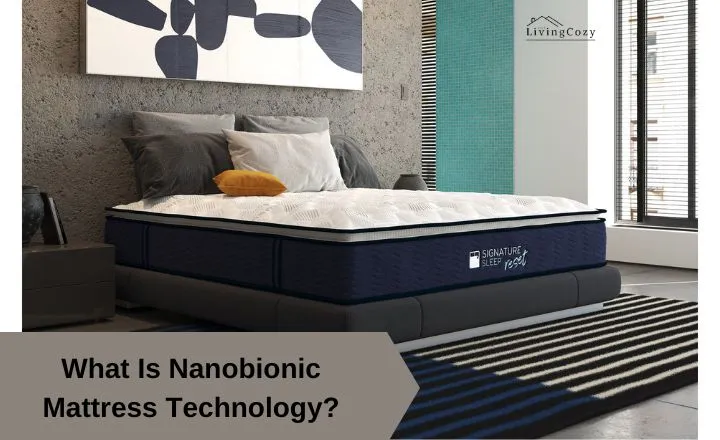A mattress that harnesses the power of nanotechnology to transform your sleeping experience into something truly extraordinary. We’ll dive deep into What is nanobionic mattress technology.
Nanobionic Mattress Technology is a revolutionary innovation that combines the science of nanotechnology with the art of sleep. Nanobionic Mattress Technology and how it works its magic to improve your overall well-being while you rest.
Nanobionic Technology is used in a number of industries with various applications, including:
- Applications in the Energy Sector
- Nanobionic Technology in the Electronics Industry
- Use of Nanobionic Technology in Textiles
- Future Prospects and Challenges
What are the benefits of sleeping on a mattress with Nanobionic Technology?
The benefit of Nanobionic Technology in mattresses is its ability to promote better blood circulation. The technology works by emitting far-infrared rays, which can penetrate deep into the body and stimulate blood flow.
This can help to relieve muscle tension and reduce pain, making it particularly beneficial for those who suffer from back or joint problems.
Sleeping on a mattress with Nanobionic Technology can provide individuals with a more comfortable and relaxing sleep experience while also offering potential health benefits such as improved blood circulation.
Does Nanobionic performance technology really work?

Nanobionic performance technology is a relatively innovation that claims to enhance athletic performance by improving blood circulation and reducing muscle fatigue.
While there is limited scientific research on the effectiveness of this technology, anecdotal evidence suggests that some individuals have experienced positive results.
It is essential to note that individual experiences may vary, and more rigorous studies are needed to establish the efficacy of Nanobionic performance technology.
The materials used in these products are generally considered safe for human contact. It is always recommended to consult with a healthcare professional before trying any new technology or product, especially if you have any underlying medical conditions or sensitivities.
Is Nanobionic technology safe?
Nanobionic technology refers to the integration of nanotechnology and biotechnology, allowing for the development of innovative materials with enhanced properties.
While this technology holds great potential in various fields, including medicine and electronics, ensuring its safety is crucial.
Will Nanobionic technology work if my skin is not in direct contact with the fabric?
Nanobionic technology relies on direct contact between the fabric and the skin to work effectively. The technology is designed to interact with the body’s natural energy and heat, which is why it needs direct contact with the skin.
If there is a barrier between the fabric and your skin, such as another layer of clothing or a protective covering, it may hinder the functionality of Nanobionic technology.
Will the reflection of Far Infrared Rays generate heat?
Yes, the reflection of Far Infrared Rays can generate heat. Far Infrared Rays are a form of electromagnetic radiation that has longer wavelengths than visible light.
These rays are reflected off a surface; they transfer their energy to the molecules on that surface, causing them to vibrate and generate heat. This is why objects or surfaces that reflect Far Infrared Rays can feel warm to the touch.
The amount of heat generated through reflection depends on various factors, such as the intensity and duration of exposure to Far Infrared Rays, as well as the properties of the reflecting surface.
Different materials have different levels of reflectivity for these rays, so some surfaces may be more efficient at generating heat through reflection than others.
What should I consider when shopping for a mattress with responsive textiles?
When shopping for a mattress with responsive textiles, there are several factors to consider. It would be best if you thought about your personal comfort preferences.
Responsive textiles can provide varying levels of support and pressure relief, so it’s essential to choose a mattress that aligns with your specific needs.
If you prefer a firmer or softer feel, as well as any particular areas of concern, such as back pain or joint issues.
Cooling Technology:
Cooling technology is a crucial aspect of our modern lives, playing a vital role in everything from our computers to our refrigerators. With the advancement of technology, the demand for efficient cooling solutions has increased exponentially. Air conditioning units are still in use, and they come with their limitations.
Personalization vs. One-Size-Fits-All:
While personalization offers individuals a sense of uniqueness and makes them feel valued as consumers, it also runs the risk of creating filter bubbles.
The algorithms only serve us content based on our preferences, and we can quickly become trapped in an echo chamber where we only see ideas that align with our existing beliefs.
This prevents us from being exposed to diverse perspectives and hinders our ability to grow and learn from others with different backgrounds and opinions.
All-Foam vs. Hybrid Construction:
All-foam and hybrid mattresses have carved a niche for themselves in the sleep industry, each boasting its own set of benefits and drawbacks.
While all foam mattresses are known for their exceptional contouring abilities, hybrids offer a blend of comfort and support. The captivating aspect of all-foam mattresses lies in their ability to conform closely to the body’s shape.
This level of contouring ensures proper spinal alignment, relieving pressure points and reducing discomfort during sleep. Hybrids combine foam layers with pocketed coils to provide optimal support while allowing for airflow.
Contouring Comfort vs. Responsiveness:
For the perfect mattress, one of the most significant factors to consider is whether you prioritize contouring comfort or responsiveness.
Contouring comfort refers to the ability of a mattress to conform and mould to your body’s shape, providing that plush, hugging sensation.
For those who value sinking into their bed and feeling like clouds are cradling them, contouring comfort is paramount.
This type of mattress can alleviate pressure points and offer exceptional support for those with ailments such as back pain or joint issues.
Some sleepers may find that too much contouring can lead to feeling too enveloped by their bed, possibly causing them to overheat during the night.
Memory Foam: Memory foam is not only used for mattresses and pillows but also has various other purposes. Healthcare professionals often use memory foam to create custom-made cushions and prosthetics to provide comfort and support to patients with disabilities or injuries.
Latex Foam: Latex foam is making a splash in the world of mattress technology, and for good reason. Memory foam, which can trap heat and cause discomfort during sleep, latex foam offers a cooler and more breathable alternative.
Latex foam is also a sustainable choice for eco-conscious consumers. Made from the sap of rubber trees, this renewable resource is biodegradable and free from harmful chemicals often found in synthetic foams.
Latex Alternative Foam: Latex alternative foam has emerged as a sustainable and viable option for those seeking an eco-friendly bedding solution. Made from plant-based materials such as soy or natural rubber, this foam offers comfort and support similar to traditional latex while reducing the environmental impact. Latex alternative foam is hypoallergenic, making it an excellent choice for individuals with allergies or sensitivities.
What are the advantages of using Nanobionic technology?

Nanobionic technology can revolutionize healthcare by enabling targeted drug delivery systems.
Nanoparticles can be designed to carry medications directly to specific cells or tissues, enhancing their effectiveness while minimizing side effects.
Nanobionic sensors can be integrated into wearable devices for real-time monitoring of vital signs or detecting early signs of diseases.
Nanobionic technology holds great promise in advancing various industries by improving material properties and enabling innovative healthcare solutions.
Conclusion:
In the above blog, we discussed What is nanobionic mattress technology. The Nanobionic mattress technology represents a significant advancement in the field of sleep science.
With the power of nanotechnology, these mattresses offer a range of benefits that can significantly improve our quality of sleep and overall health.
From enhancing circulation to reducing pain and inflammation, the potential applications for this technology are vast.
FAQ’s:
What are nanobionic sheets?
Nanobionic sheets are a type of advanced textile technology that combines nanotechnology and bionics.
These sheets are made by embedding nano-sized particles into the fabric, which can then interact with the body’s natural energy fields.
What is a nanobionic mattress pad?
A nanobionic mattress pad is a technologically advanced bedding accessory that combines the benefits of nanotechnology and bionics. It is designed to enhance sleep quality.


